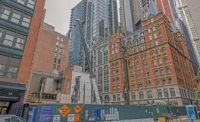The old GM plant in Ewing, N.J., once churned out planes during World War II. But after closing in 1998, the factory sat vacant for years. Now it's being transformed into a large mixed used development that will serve as a town center for the sprawling suburb of Ewing Township.
Long a center for manufacturing and heavy industry, New Jersey has no shortage of industrial sites that have seen better days. But thanks to the state’s two-decade-old brownfields initiative, some are now being transformed, like the old factory in Ewing, into ambitious, mixed-used projects.
And riding the trend has been Spiezle Architecture Group, with the Camden, N.J.-based firm having carved out a niche as the planner on a number of major brownfields redevelopment projects, including the one in Ewing.
“New Jersey being the most urbanized state in the nation, with a lot of industrial sites and abandoned industrial areas and limited open space, has led the way in the last 20 years in trying to find ways to promote brownfields redevelopment,” said Angelo Alberto, a principal at Spiezle. “It has become a model for other states to follow.”
The project at the 80-acre former GM site, once home to a 1.1 million sq ft factory, is nearing the halfway point. When complete, the project will include 1,100 apartments and townhomes, a main street-style retail and restaurant corridor, biking and walking trails and a 10,000-sq-ft clubhouse.
Cutting Red Tape and Offering Incentives
The Garden State’s approach to redeveloping brownfields has taken shape over the past two decades and relies on a mix of zoning relief and incentives.
The New Jersey Local Redevelopment and Housing Law enables developers of brownfield sites to set aside restrictive local zoning rules. which might limit a site to industrial uses or have other restrictions.
The law allows sites to be designated “An Area in Need of Redevelopment,” granting developers and designers the freedom to envision a new future for old factories and other industrial facilities by setting aside rules that no longer make sense limiting height and density or prohibiting residential and retail development.
Along with lifting bureaucratic restrictions, the designation of a site as a redevelopment area also enables the developer and local officials to gain access to a series of subsidies.
In addition to tax credits and payment-in-lieu-of-taxes agreements, which reduce the financial burden on a project during its initial years, there is also funding for the inevitable environmental remediation, Spiezle’s Alberto noted.
“When designated “Redeveloper,” a development entity can much more confidently move forward with key investments such as market studies and environmental cleanup,” Alberto recently wrote in an op-ed for ROI, a local publication.
For its part, Spiezle has capitalized on the opportunities opened up by the Garden State’s efforts to promote brownfields redevelopment.
Working with developer Atlantic Realty Development Corp., Spiezle is well along in its work on its planning and design work on the Ewing Town Center project.
Meanwhile, Spiezle’s work helping redevelop a riverfront site in Cherry Hill won the N.J. Future Smart Growth Award.
The project, 202 Park, involved transforming an underutilized and blighted hotel site into 192-unit residential complex featuring everything from luxury penthouse apartments to affordable housing. The project also included charging stations for electric vehicles and rooftop solar panels.
Overall, the process of redeveloping a brownfields site can be a lengthy one, with some sites too environmentally damaged to be brought completely up to residential standards, Alberto said. In those cases, the site itself might be capped, with parking and retail on the ground floor and apartments above.
“The redevelopment process, especially for larger projects, can take years,” Alberto said. “You are going to be faced with a number of different challenges.”





Post a comment to this article
Report Abusive Comment